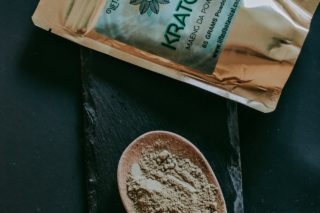What is Kratom?
Kratom is an evergreen tree in the coffee family that mainly grows in Southeast Asia. People have used the leaves from this tree in traditional and herbal medicine practices for generations in Malaysia and Thailand. Kratom use is becoming more popular in the United States as people look for a, “legal high.”
Kratom comes from the Mitragyna speciosa plant and is commonly sold in tablet or powder form as a, “dietary supplement.” Kratom is usually sold as, “incense,” in head shops. Even though the DEA has not scheduled kratom as a controlled substance, the U.S. Food and Drug Administration (FDA) closely monitors kratom shipments to the United States and frequently detains and denies shipments because of the substance’s potentially toxic effects.
What Does Kratom Do?
When taken in low doses, kratom can cause a stimulant effect that can boost energy levels. In higher doses, kratom’s effects are similar to opioids and can induce euphoria, sedation, and even a ‘dreamlike’ state.
Similar to opiates, the body can become dependent on kratom if it is used regularly. When the brain becomes dependent on psychoactive substances like kratom, both physical and mental withdrawal symptoms can happen once you stop using the substance.
Kratom is believed to have the most similar effects and functions as opioid drugs since it works on some of the same neuropathways. This is also why kratom withdrawal can be just as difficult as opioid withdrawal and include severe depression, anxiety, and cravings.
Some people try to falsely promote kratom as a remedy or cure for heroin addiction and withdrawal symptoms. Although kratom might seem like an effective alternative to heroin or opioids since it fills the same opioid receptors, the use of kratom with this intent is extremely dangerous. Kratom can lead to drug dependence and will require the same arduous medical detoxification and treatment program as heroin and other opiates.
How is Kratom Used?
Traditional kratom use in Southeast Asia is done by chewing or brewing dried kratom leaves into tea.
However, in the United States, kratom comes in capsule or tablet form — allowing an individual to get a higher dose than intended or that would be medically useful in any way.
Higher doses that are more concentrated can cause severe side effects more quickly because herbal supplements are not FDA-regulated.
It is still possible for people with high opioid tolerances to overdose because they do not know how to properly dose the substance for themselves. Some people claim that kratom can be used as an effective opioid addiction treatment, just as Buprenorphine/Naltrexone or buprenorphine do. This claim has not been studied thoroughly and is not verified, but the dangers of kratom use are well-documented.
The Effects of Kratom Use
The primary ingredient in kratom, mitragynine, produces effects that fluctuate in severity with the dosage. For example, in smaller doses, effects include:
- Increased energy
- Decreased need for sleep
- Increased concentration
- Increased talkativeness
- Feeling more friendly and social
When taken at higher doses, effects include:
- Sedation
- Lowered levels of anxiety
- More euphoric effects
- Reduced pain
- Extreme perspiration
- Itching
- Dry mouth
Long-term kratom use has been linked with:
- Weight loss
- Appetite loss
- Insomnia
- Darkened skin tone
- Hallucinations
- Delusions
- Frequent urination
- Constipation
Kratom should be considered a potentially dangerous drug because:
- The drug is not federally regulated, which means you do not know what you are really getting when you buy it.
- There is a lack of information about the potentially dangerous interactions between kratom and other medications used for the treatment of drug withdrawal and dependence. Although there are a number of unverified reports that show kratom has helped people withdraw from opiates, there are no formal kratom withdrawal management rules and no professional organization recommends kratom use of any kind.
- Any drug that produces withdrawal symptoms should be considered a potentially dangerous substance because so many complications can occur during withdrawal.
Kratom Withdrawal — What Does it Look Like?
Once the body becomes physically dependent on kratom and you stop taking the substance, your body will begin the withdrawal process. That is because dependence always leads to withdrawal. Symptoms of kratom withdrawal start within several hours of taking your last dose and include:
- Sweating
- Runny nose
- Watery eyes
- Severe abdominal pain
- Vomiting
- Nausea
- Muscle pain
- Spasms
- Muscle weakness
- Irritability and mood swings
- Restlessness
- Aggression
- Blurred vision
- Insomnia
- Hand tremors
- Diarrhea
- Mild hallucinations (rare cases)
- Cravings for kratom
- Restless legs
These symptoms typically peak within one to two days and then decrease in intensity. After the symptoms peak, they can continue to linger for three to five days.
In some cases where medical professionals treat withdrawal syndrome, the symptoms can successfully be treated with benzodiazepines and NSAIDs, like Tylenol.
The Dangers of Kratom Withdrawal
Even though the symptoms of kratom withdrawal are not considered to be fatal on their own, there are still dangers associated with kratom withdrawal:
- Although hallucinations are rare, it still presents a potentially dangerous situation if you are not in a controlled environment.
- People experiencing mood swings might be at risk for poor judgment and decisions that could lead to accidents or harming themselves or others.
- People who are nauseous and vomiting risk becoming dangerously dehydrated.
- Because of severe cravings and the physical and emotional distress that happens during withdrawal, some people may relapse and potentially overdose in an attempt to deal with the discomfort.
- Kratom use can be fatal. Fatalities are caused by people who use kratom in combination with other medications or drugs.
Kratom Withdrawal Timeline
The duration and the speed of the onset of withdrawal symptoms depend on the dose and length of kratom use. A general timeline of what most people experience during kratom withdrawal is provided below:
- The First 12 Hours: Flu-like symptoms and heightened depression and anxiety.
- Days 1-3: Symptoms normally peak during this time. People are most at risk of relapsing during this period to deal with the discomfort from the peak of withdrawal.
- Days 4-7: During this period, the most severe symptoms will dissipate.
Although the worst of the symptoms subside within about one week, milder symptoms linger for months or even years. This is especially true for heavy kratom users. Psychological symptoms like mood swings, depression, anxiety, and cravings can also stick around.
Finding Relief from Kratom Withdrawal Symptoms
There are some techniques that help lessen the symptoms of kratom withdrawal, including:
- Take an over-the-counter pain reliever, like Tylenol, aspirin, or ibuprofen — these can help relieve muscle aches and fever.
- Stay hydrated — withdrawal symptoms, including vomiting, diarrhea, and excessive sweating all contribute to dehydration. Make sure you drink plenty of fluids. We recommend water and a rehydrating solution such as Pedialyte. These solutions help replenish lost water and electrolytes.
- Take an over-the-counter anti-diarrheal drug, like Pepto-Bismol or Imodium, to reduce or prevent diarrhea.
- Eat small meals frequently. This coupled with a bland diet can help with nausea, vomiting, and stomach discomfort.
- Take an over-the-counter antiemetic drug, like Gravel, Pepto-Bismol, and Dramamine. These medications can help relieve nausea and vomiting. You can also try ginger chews or tea to help soothe your stomach.
- Use relaxation techniques like breathing exercises, mediation, and yoga. These methods are proven to improve pain, anxiety, and insomnia.
- Get adequate sleep. Aim for a full 6-8 hours of sleep each night. Take naps during the day if you need them. Getting enough sleep can help lower irritability and anxiety.
- Use heating pads, hot baths, and ice to help with muscle aches.
- Take part in hobbies you enjoy — this will help keep your mind active and off of your symptoms. Try things like your favorite movies, books, adult coloring books, puzzles, and music.
- Talk to a friend or family member. Emotional support goes a long way in helping your body heal physically and emotionally. Whether it is for one meal or an entire weekend, visits with the people we love can provide needed support to manage withdrawal symptoms, and it can also be a pleasant distraction.
- Get professional help. The safest and most effective way to manage withdrawal symptoms and decrease your risk of relapse is finding a treatment center. Through mediation and ongoing therapy, you can heal your body and mind from kratom addiction and take back your life.
Safely Detoxifying from Kratom
You do not have to go through kratom withdrawal alone. Detoxification programs help provide a structured environment and around-the-clock support to ensure you have a successful detoxification. During medically supervised detoxification, a team of professionals will evaluate your physical and mental well-being and provide treatment.
The benefits of undergoing a supervised kratom detoxification program include:
- Increased patient safety
- Medical assistance during complications
- Lower relapse rate
Attempting to undergo detoxification alone or at home can be dangerous and can lead to serious health complications. When detoxification is performed under professional medical care, most of the complications can be avoided.
Medical professionals can prescribe medications to help better manage the symptoms and physical discomfort, which makes detoxification and withdrawal more manageable.
If you have been using substances and you have a mental health disorder, you may need to enter a medical treatment program that treats dual diagnosis conditions. Dual diagnosis treatment can be completed at a faster rate because the more specific the diagnosis, the easier it is to identify the right courses of action. Since addiction and mental health commonly go hand-in-hand, it is effective to treat both conditions at once instead of separately.
Frequently Asked Questions about Kratom Withdrawal
How long does kratom withdrawal last?
Kratom withdrawal is often linked with opioid withdrawals — which start within six to twelve hours of the last dose. Withdrawal symptoms peak within two to three days and can last between five to ten days. You can generally expect kratom withdrawal to last about a week for someone who is heavily dependent on the drug. As we mentioned, the length of withdrawal symptoms are closely linked to the level of dependency — biology, genetics, history of addiction, other medical/psychological issues, co-occurring addictions, and other environmental factors can also influence how dependent each person becomes to kratom.
Are there any possible negative drug reactions with kratom?
According to the DEA, a popular drink has been circulating among young people in Thailand, known as 4×100. It’s a mixture of the plant-based kratom and codeine-based cough syrup, resulting in a caffeinated drink that produces an effect similar to alcohol. It is highly dangerous to mix kratom with other psychoactive substances because they may have negative interactions with each other. Seizures have been reported when kratom was taken with other drugs.
Other reports have found worsened depression and possibly fatal drug interactions between kratom and other opioids, like morphine or hydrocodone.
Windward Way Recovery Can Help
The staff at Windward Way Recovery is compassionate, experienced, and dedicated to providing custom treatment programs to each one of our clients. From group therapy to individual therapy — and even art and nature therapy, we offer a broad spectrum of treatment options and paths, including an intensive outpatient program in order to provide an effective treatment process and improve the quality of life of our clients. Contact us today. We are here for you.






